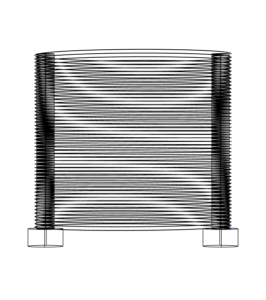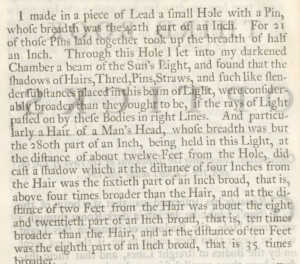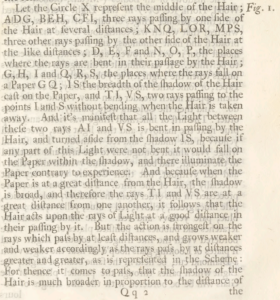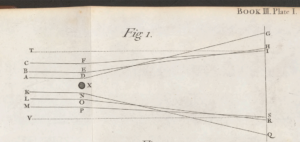David Rittenhouse and the First Diffraction Grating by Ayra Gulati
Primary Document
JSTOR Document of correspondence between David Rittenhouse and Francis Hopkinson with regard to an optical problem
https://www.jstor.org/stable/pdf/1005186.pdf
Description:
Drawing inspiration from Francis Hopkinson’s optical problem with the cross hairs of a silk handkerchief, David Rittenhouse used two threaded brass screws with thin hairs arranged parallel to one another to create the first diffraction grating. The thin hairs arranged 1/250th of an inch apart, revealed an interference pattern with 6 spectral lines on each side.
Visual representation of Hopkinson’s optical problem

What did the Rittenhouse experiment reveal?
After making the diffraction grating using brass screws and hairs, Rittenhouse pointed a beam of light through his makeshift grating. He observed that as the light hit the parallel hairs, a pattern of dark and light hairs or a diffraction pattern was formed. Rittenhouse was able to associate the distance between the dark and light lines with the distance between the parallel hairs arranged in the screw.
Using a measuring device from his telescope, Rittenhouse was able to find the angle made by the different colored bands. He associated the angles of the bars of the same colors with the perpendicular as integral multiples of the angle the innermost colored bar made with the normal.
His initial findings helped scientists understand the behavior of light as it moved through the tiny gaps of his diffraction grating and led to the creation of more advanced diffraction gratings that were able to see how light interacted with smaller gaps, enabling them to analyze the behavior of light more precisely.
Rittenhouse’s first Diffraction Grating: Digital Model made via COMSOL

______________________________________________________________
Primary Document
Library of Congress online pdf of Newton’s book on Opticks titled, Opticks: or, A treatise of the reflexions, refractions, inflexions, and colours of light (Also two treatises of the species and magnitude of curvilinear figures)
https://www.loc.gov/resource/rbctos.2017gen39060/?st=pdf&pdfPage=1
Description:
Newton describes his work and experiments with regard to light interacting with prisms and the resulting diffraction of sunlight into different colors of light.
Rittenhouse and Newton’s study of “Inflexion” of light
Sir Issac Newton conducted an experiment involving a prism and sunlight. He found that the sun’s light was diffracted through the prism, creating a rainbow of primary color. During his time, Newton’s findings were not widely accepted by the scientific community, but Rittenhouse was able to find value in his discovery. This diffraction of light was a phenomenon that Newton described as inflexion of light. This inflexion of light, now known as diffraction, was cited by Rittenhouse to describe the behavior of light in Hopkinson’s experiment.
Rittenhouse’s citation of Newton
(located on page 205 of 1st primary document)

Newton describes an experiment with components similar to Rittenhouse’s
(located on page 114 of Newton’s 3rd book on Opticks, page 316 of overall pdf)

Explanation + Results of Newton’s Experiment
(located on page 115 of Newton’s 3rd book on Opticks, page 317 of overall pdf)

(located on page 341 of pdf)
